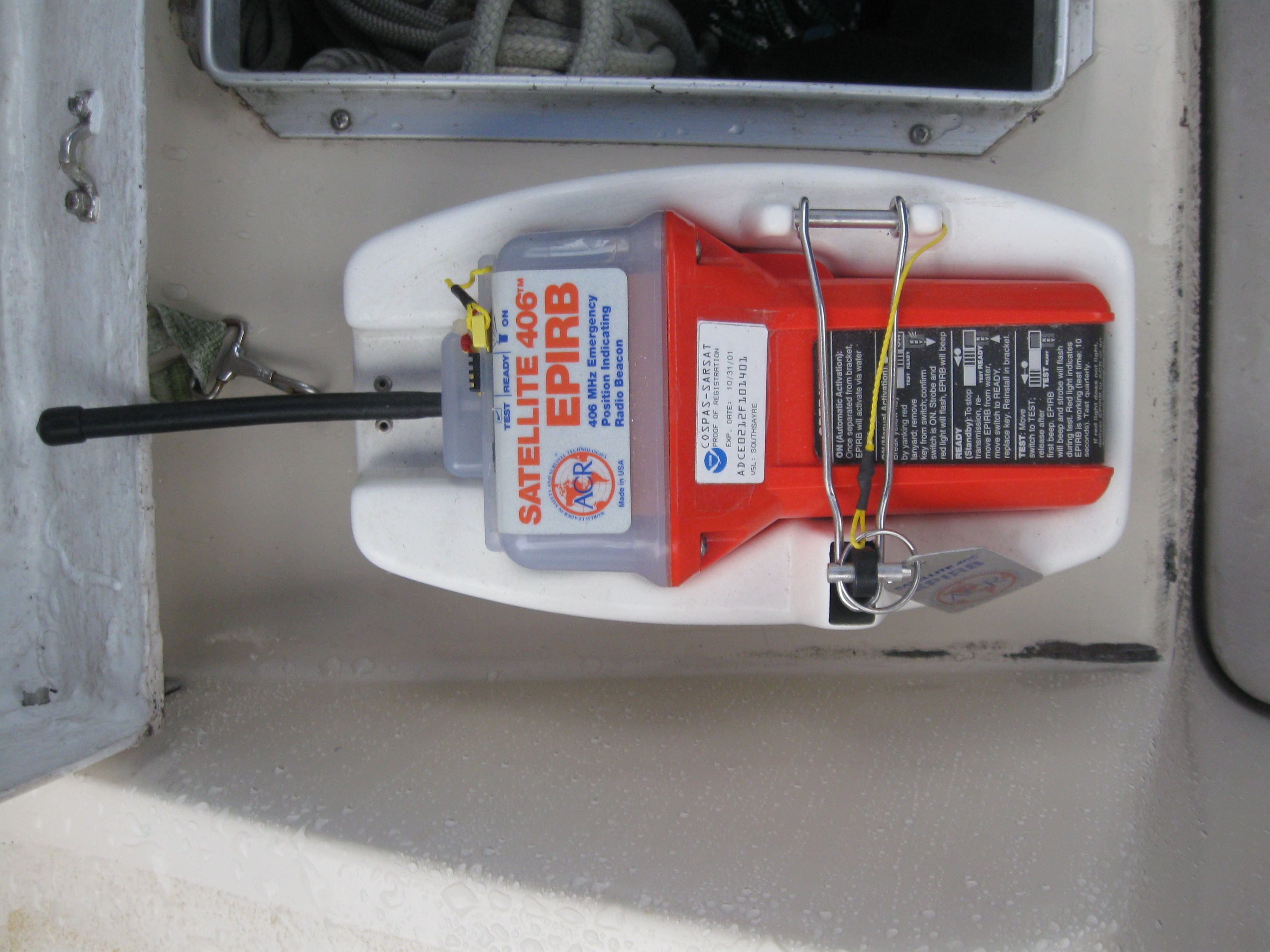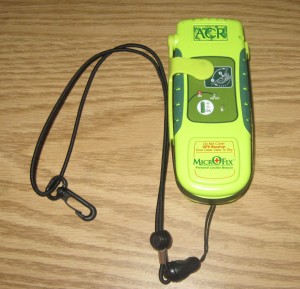One of the single most important developments for marine safety has been the EPIRB and more recently the PLB. What are EPIRBs and PLBs? EPIRBs (emergency position-indicating radio beacons) and PLBs (personal locator beacons) are small self contained transmitters that broadcast an emergency locating signal. The first EPIRBs were developed during WWII to help locate downed airmen. These units were bulky and difficult to deploy making them impractical for private use. As technology improved and equipment became more robust and smaller, it became more practical to produce units that could be used by the private sector. The disappearance of Congressmen Hale Boggs (D-LA) and Nick Begich (D-AK) in the Alaskan wilderness in 1972 was the catalyst for a U.S. law mandating that all aircraft carry an emergency locator transmitter. This was the beginning of the modern EPIRB. Over the years since, emergency beacons have gone through several changes to become what they are now. Today’s beacons are sophisticated units that communicate with satellites to give information about who is in distress and their location. Some can now even allow the user to transmit short “I’m OK” messages. Almost all modern units also now have built in GPS receivers to transmit the exact location of the unit. Let’s take a quick look at the types of units most boaters are likely to use.
There are basically 3 types of emergency locator beacons.
EPIRB/GPRIB – (Emergency Position Indicating Radio Beacons, GPIRB combined GPS EPIRB) signal maritime distress.
ELTs- (Emergency Locator Transmitters) signal aircraft distress.
PLBs – (Personal Locator Beacons) are for personal use and are intended to indicate a person in distress who is away from normal emergency services (i.e., 9-1-1)
As mariners we are primarily only interested in the EPIRB/GPRIBs and PLBs. These units come in a few sub classes as follows:
Category I – 406/121.5 MHz. Float-free, automatically activated EPIRB. Detectable by satellite anywhere in the world. Recognized by GMDSS (Global Maritime Distress Safety System.)
Category II – 406/121.5 MHz. Similar to Category I, except is manually activated. Some models are also water activated.
Classes no longer used or monitored by satellite are the units that transmit soley on 121.5/243 MHz. These classes are as follows”
Class A- Float-free, automatically-activating.
Class B – Manually activated version of Class A, also known as Mini B.
Class C – Marine VHF ch15/16. Manually activated, these beacons operate on maritime channels only, and therefore are not detectable by satellite or normal aircraft.
Class S – Similar to Class B, except it floats, or is an integral part of a survival craft (lifeboat).
The class A, B, C, and S units that transmit only on 121.5/243 MHz are being phased out in the US. Since 1 February 2009, only 406 MHz beacons are monitored by the international Cospas-Sarsat SAR satellite system. This does not mean these units are useless, as aircraft and some shore stations are still monitoring the 121.5/243 MHz frequencies. However you should not consider these units as a primary life saving device. Your odds of the signal being detected are less and the time it would take for a SAR (Search and Rescue) team to verify and respond to your signal could be many hours. The 121.5/243 MHz units are still used for onboard MOB (Man Overboard) systems that have a receiver/direction finder on the main vessel. These systems have a special direction finding receiver that will allow the vessel to begin recovery of a MOB immediately and not have to wait for the arrival of outside help. If you currently have a 121.5/243 MHz device onboard and it is still operational with a good battery you might as well keep it, as any and all means for rescue should be used, however you should also have a newer Category I or II device onboard as well. The 121.5/243 MHz units will transmit a continuous tone for location purposes. This tone does not contain any information about the transmitter or its location. A SARS team has to first verify the signal is not a false one. They then have to home in on the signal to locate the transmitter. All this takes precious time and can make locating someone in distress difficult. The fact that the unit has to transmit continuously reduces battery life as well.
The Class I and II, 406 MHz, EPIRB/GPRIB and PLB all transmit to satellites that are part of the Cospas-Sarsat system. Cospas-Sarsat is an international satellite-based search and rescue (SAR) distress alert detection and information distribution system, established by Canada, France, the United States, and the former Soviet Union in 1979.The signal will be responded to in minutes rather than the hours it may take for 121.5/243 MHz unit, that first must be noticed by a passing aircraft or shore station. The 406 MHz units operate differently as well; they transmit bursts of digital data containing information about the beacon and its location. By transmitting in short bursts they use less battery power and can operate longer. Because these units transmit more information it is important to have your unit registered. When a signal is received it has to be authenticated before any rescue effort is made. With a registered unit authorities can begin contacting those listed in the registration information to verify whether there is a real possibility of distress. With an unregistered beacon the SAR authorities have a harder time verifying that it is not a false alarm slowing rescue efforts. Registration is free and relatively easy. In the US NOAA is the agency in charge of registrations. You can set up an account online at the NOAA website, https://beaconregistration.noaa.gov/rgdb/. NOAA requires that the registration be updated every 2 years. NOAA will mail you a notice every 2 years that you can update as needed and return by mail. Registration is needed but not required for both EPIRBs and PLB beacons. If you have an unregistered beacon it can still be used however rescue efforts maybe be slowed down. It is best to register the unit when you purchase it and keep the information up to date.
The primary difference between an EPIRB/GPIRB and a PLB is in their size and method of deployment. EPIRBs are designed to be part of a vessels equipment while the PLBs are designed for personal use and are therefore smaller. Marine EPIRBs are designed to float and most come with an optional hydrostatic release and automatic activation. Almost all EPIRBs made today have built in GPS functions, older unit may not have this feature. EPIRBs have batteries that will operate the unit for 48+ hours while the PLBs generally last only about 24-36 hours. PLBs were originally designed for hikers, hunters and others that may venture out of cell phone range. Because of the lower cost many mariners are opting to use PLBs instead of a dedicated vessel EPIRB. For costal use within 100 miles from shore this is a good option. PLBs are also small enough to be carried at all times a real safety advantage in the event of a MOB. Another advantage is that they can be used off the boat for camping and hiking. The disadvantages are that not all units float, they have shorter battery life when activated, and they must be manually activated. Despite these disadvantages there lower cost (about 1/3 that of an EPIRB) make PLBs a good alternative for the coastal cruiser. To add to the confusion there are now devices out called Personal Locators not to be confused with Personal Locator Beacons. These devices use a subscription services that are operated by private companies. There are some advantages in that you can send limited messages and can get real time tracking that friends at home can use. But keep in mind these are services may have limited operational areas and are not government run. You have to keep up with the yearly subscriptions at an additional cost as well. Before you purchase a PLB make sure you understand its abilities and limitations.
Maintaining an EPIRB or PLB is relatively easy. They should be visually inspected and a self test performed at least once a month and about 2 weeks prior to any trips. A careful inspection of the case for cracks is important as any moisture getting into them can make them inoperable. If you have a hydrostatic release it should be inspected as well. Check the battery expiration date, if it is getting close to its due date you should remove the unit from service at a time you are not likely to need it for awhile. Battery replacement must be done by an authorized size center and is not cheap generally running about $350 for a EPIRB and about $200. This may seem expensive for a battery replacement but it includes a full service and testing of the unit and may include software and/or hardware upgrades if needed. All beacons have a 10 year life span and batteries can be replaced twice during that period. This means if you replace your batteries as needed you should get a 15 year service life. If you wait till the unit is past its last battery replacement date and the unit is older than 10 years it can no longer be serviced.
Emergency beacons are improving every year, making this great asset to our safety even better. With prices dropping and systems becoming more useful it makes little sense not to set sail without one. Even coastal cruisers can benefit from the added piece of mind of having a PLB at an affordable cost. If you are planning an offshore passage you can now rent an EPIRB by the week or month. These units can mean the difference between life and death at sea. Emergencies and accidents can happen within sight of land and may not always allow time for radio transmissions from traditional sources. Having an EPRIB or PLB can provide added safety and peace of mind for even short voyages.
/span

